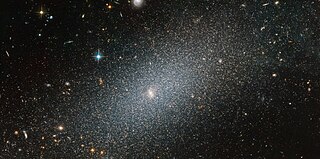
Dwarf elliptical galaxies (dEs) are elliptical galaxies that are smaller than ordinary elliptical galaxies. They are quite common in galaxy groups and clusters, and are usually companions to other galaxies.
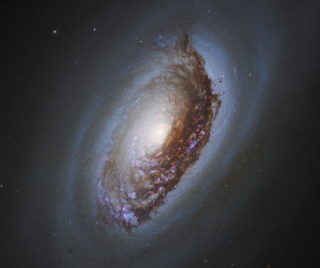
The Black Eye Galaxy is a relatively isolated spiral galaxy 17 million light-years away in the mildly northern constellation of Coma Berenices. It was discovered by Edward Pigott in March 1779, and independently by Johann Elert Bode in April of the same year, as well as by Charles Messier the next year. A dark band of absorbing dust partially in front of its bright nucleus gave rise to its nicknames of the "Black Eye", "Evil Eye", or "Sleeping Beauty" galaxy. M64 is well known among amateur astronomers due to its form in small telescopes and visibility across inhabited latitudes.

Messier 94 is a spiral galaxy in the mid-northern constellation Canes Venatici. It was discovered by Pierre Méchain in 1781, and catalogued by Charles Messier two days later. Although some references describe M94 as a barred spiral galaxy, the "bar" structure appears to be more oval-shaped. The galaxy has two ring structures.
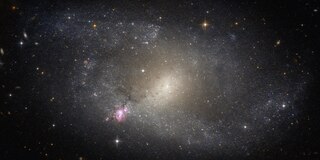
NGC 5398 is a barred spiral galaxy in the southern constellation of Centaurus. It was discovered June 3, 1836 by John Herschel. Distance estimates range from 5.39 Mpc to 18.30 Mpc. The tip of the red-giant branch method yields a distance of 11.6 Mpc, while the Tully–Fisher relation shows values of around 8.5 Mpc. It is receding with a heliocentric radial velocity of 1,219 km/s.

NGC 4697 is an elliptical galaxy some 40 to 50 million light-years away in the constellation Virgo. It is a member of the NGC 4697 Group, a group of galaxies also containing NGC 4731 and several generally much smaller galaxies This group is about 55 million light-years away; it is one of the many Virgo II Groups, which form a southern extension of the Virgo Supercluster of galaxies.

NGC 660 is a peculiar and unique polar-ring galaxy located approximately 45 million light-years from Earth in the Pisces constellation. It is the only such galaxy having, as its host, a "late-type lenticular galaxy". It was probably formed when two galaxies collided a billion years ago. However, it may have first started as a disk galaxy that captured matter from a passing galaxy. This material could have, over time, become "strung out" to form a rotating ring.

NGC 4138 is the New General Catalogue identifier for a lenticular galaxy in the northern constellation of Canes Venatici. Located around 52 million light years from Earth, it spans some 2.1 × 1.3 arc minutes and has an apparent visual magnitude of 11.3. The morphological classification of NGC 4138 is SA0+(r), indicating it lacks a bar formation and has tightly wound spiral arms with a ring-like structure around the nucleus. It has no nearby companion galaxies.
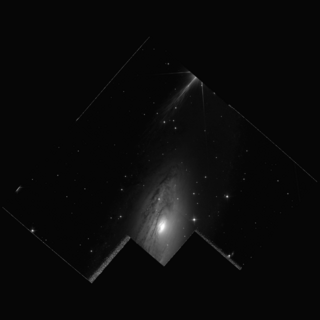
NGC 7013 is a relatively nearby spiral or lenticular galaxy estimated to be around 37 to 41.4 million light-years away from Earth in the constellation of Cygnus. NGC 7013 was discovered by English astronomer William Herschel on July 17, 1784 and was also observed by his son, astronomer John Herschel on September 15, 1828.
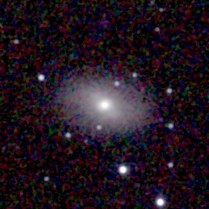
NGC 7079 is a barred lenticular galaxy located about 110.58 million light-years away in the constellation of Grus. NGC 7079 is also classified as a LINER galaxy. It is tilted about 51° to the Earth's line of sight. NGC 7079 was discovered by astronomer John Herschel on September 6, 1834.
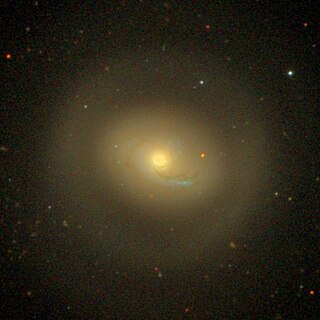
NGC 4457 is an intermediate spiral galaxy located about 55 million light-years away in the constellation of Virgo. It is also classified as a LINER galaxy, a class of active galaxy defined by their spectral line emissions. NGC 4457 Is inclined by about 33°. It was discovered by astronomer William Herschel on February 23, 1784. Despite being listed in the Virgo Cluster Catalog as VCC 1145, NGC 4457 is a member of the Virgo II Groups which form an extension of the Virgo cluster.

NGC 4429 is a lenticular galaxy located about 55 million light-years away in the constellation of Virgo. NGC 4429 is tilted at an inclination of about 75° which means that the galaxy is tilted almost edge-on as seen from Earth. NGC 4429 was discovered by astronomer William Herschel on March 15, 1784. The galaxy is a member of the Virgo Cluster.

NGC 4689 is a spiral galaxy located about 54 million light-years away in the constellation of Coma Berenices. NGC 4689 is also classified as a LINER galaxy. NGC 4689 is inclined at an angle of about 36° which means that the galaxy is seen almost face-on to the Earth's line of sight. NGC 4689 was discovered by astronomer William Herschel on April 12, 1784. The galaxy is a member of the Virgo Cluster.
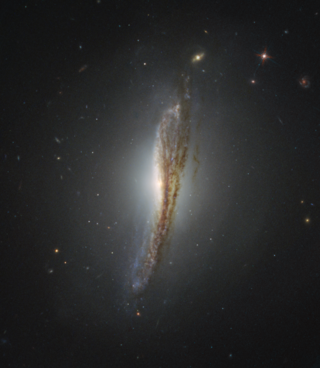
NGC 612 is a lenticular galaxy in the constellation of Sculptor located approximately 388 million light-years from Earth. It is a type II Seyfert galaxy and thus has an active galactic nucleus. NGC 612 has been identified as an extremely rare example of a non-elliptical radio galaxy, hosting one of the nearest powerful FR-II radio sources.

NGC 7469 is an intermediate spiral galaxy in the constellation of Pegasus. NGC 7469 is located about 200 million light-years away from Earth, which means, given its apparent dimensions, that NGC 7469 is approximately 90,000 light-years across. It was discovered by William Herschel on November 12, 1784.

NGC 541 is a lenticular galaxy located in the constellation Cetus. It is located at a distance of circa 230 million light years from Earth, which, given its apparent dimensions, means that NGC 541 is about 130,000 light years across. It was discovered by Heinrich d'Arrest on October 30, 1864. It is a member of the Abell 194 galaxy cluster and is included in the Atlas of Peculiar Galaxies in the category galaxies with nearby fragments. NGC 541 is a radio galaxy of Fanaroff-Riley class I, also known as 3C 40A.
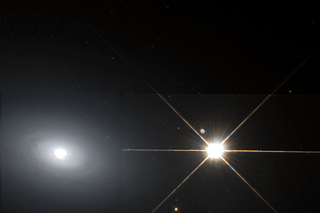
NGC 2974 is a lenticular galaxy located in the constellation Sextans. It is located at a distance of circa 90 million light years from Earth, which, given its apparent dimensions, means that NGC 2974 is about 90,000 light years across. It was discovered by William Herschel on January 6, 1785. NGC 2974 is located in the sky about 2 and a half degrees south-south east of Iota Hydrae and more than 6 degrees northeast of Alphard. A 10th magnitude star lies next to the galaxy, thus making it a challenging object at low magnifications. NGC 2974 is part of the Herschel 400 Catalogue.

NGC 4513 is a lenticular galaxy and a ring galaxy located about 110 million light-years away in the constellation Draco. It was discovered by astronomer Heinrich d'Arrest on October 16, 1866.

NGC 1142 is a distorted spiral galaxy in the constellation of Cetus. It is located about 370 million light years away from Earth, which means, given its apparent dimensions, that NGC 1142 is approximately 170,000 light years across. It is a type 2 Seyfert galaxy. It interacts with the elliptical galaxy NGC 1141.
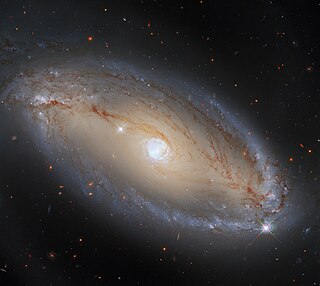
NGC 5728 is an active barred spiral galaxy located 146 million light years away in the southern constellation of Libra. It was discovered on May 7, 1787 by William Herschel. The designation comes from the New General Catalogue of J. L. E. Dreyer, published in 1888. It has an apparent visual magnitude of 13.40 and spans an angle of 3.4 arcminutes. The galaxy shows a red shift of 0.00935 and has a heliocentric radial velocity of 2,803 km/s. It has an estimated mass of 72 billion times the mass of the Sun and stretches around 30 kpc across.

NGC 4324 is a lenticular galaxy located about 85 million light-years away in the constellation Virgo. It was discovered by astronomer Heinrich d'Arrest on March 4, 1862. NGC 4324 has a stellar mass of 5.62 × 1010M☉, and a baryonic mass of 5.88 × 1010M☉. The galaxy's total mass is around 5.25 × 1011M☉. NGC 4324 is notable for having a ring of star formation surrounding its nucleus. It was considered a member of the Virgo II Groups until 1999, when its distance was recalculated and it was placed in the Virgo W Group.




















